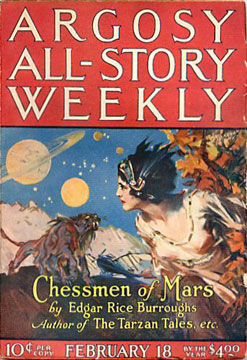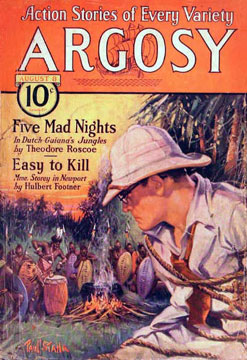The Argosy
The Argosy was the first pulp magazine and progenitor of an entire medium. It did not begin as a pulp, however, but as a weekly "story paper" titled The Golden Argosy, consisting of youth-oriented fiction and "rags to riches" tales by the likes of Horatio Alger, Jr. and Edward S. Ellis. It was the brainchild of Frank Andrew Munsey, a Western Union telegraph manager who dreamed "great dreams to the tune of the printing-press."
Munsey moved to New York City in September 1882. Following several months of financial hardships and entrepreneurial uncertainty, he published the first issue of The Golden Argosy (December 9, 1882). After several years, the drawbacks of producing a paper specifically for juvenile readers led Munsey to rethink his targeted audience. Juvenile audiences continuously outgrew the medium, and they lacked disposable incomes of their own that would attract advertisers.
Following this reasoning, the all-new Argosy appeared in October 1896; the magazine was now intended for an adult audience, and was produced on less-expensive pulpwood paper, allowing for a substantial increase in page numbers and content. This new type of periodical, the pulp magazine, was a runaway success, and within ten years Argosy's circulation had surpassed 500,000 a month. Over the next several decades, other Munsey titles were incorporated into Argosy, such as Railroad Man's Magazine in 1919, and All-Story Weekly in 1920.
Argosy was a showcase for popular fiction of every genre imaginable. Western, romance, adventure, war, crime, and science-fiction stories all found their home in Argosy. Argosy published the works of popular pulp authors such as Edgar Rice Burroughs, Max Brand, Malcolm Wheeler Nicholson, H. Bedford Jones, Fred MacIssac, and scores of others.
In the years and months preceding Pearl Harbor, Argosy shed its all-fiction persona, and began to incorporate "real-life" articles, such as those predicting German attacks on New York or detailing Japanese atrocities in occupied China. In 1942, Argosy was sold to Popular Publications, which also owned Argosy's chief rival, Adventure; an action that resulted in further editorial augmentations.
Over the course of the late 1940s and early 1950s, Argosy became a "men's" magazine, and the quality of its fiction diminished. The title continued as a general interest periodical through the 1960s and 70s, with special "annual" issues dedicated to topics such as Bigfoot, the Bermuda Triangle, and UFOs. Argosy finally ceased publication in 1979, ninety-seven years after its inception.
Nathan Vernon Madison, Virginia Commonwealth University
Works Cited
Britt, George. Forty Years - Forty Millions : The Career of Frank A. Munsey (Port Washington: Kennikat Press, 1972), 87.
Frank A. Munsey, The Founding of the Munsey Publishing House, Quarter of a Century Old - The Story of the Argosy, Our First Publication, and Incidentally The Story of Munsey's Magazine (New York: Frank A. Munsey Company, 1907), 10.





